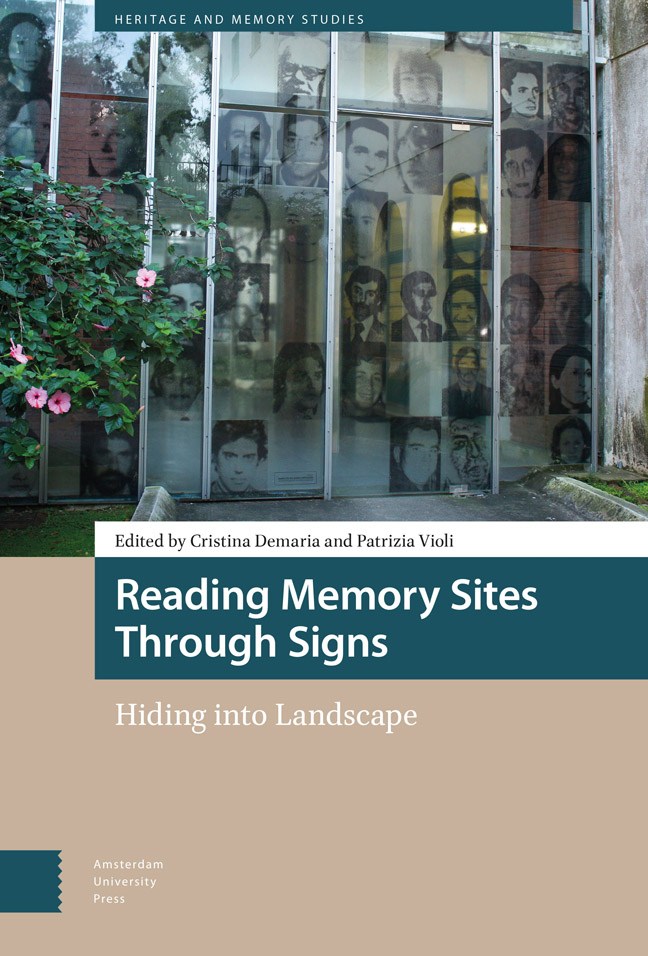Book contents
- Frontmatter
- Contents
- List of Illustrations
- For a Semiotics of Spaces of Memories: Practices of Enunciation and Narratives from Monuments to Global Landscapes of Inheritance
- 1 Stories that Shape Spatialities: Lieu and Milieu de Mémoire through the Lens of Narrativity
- 2 Interpretation and Use of Memory: How Practices Can Change the Meanings of Monuments
- 3 Uncomfortable Memories of Fascist Italy: The Case of Bigio of Brescia
- 4 What Does Fascist Architecture Still Have to Tell Us?: Preservation of Contested Heritage as a Strategy of Re-Enunciation and ‘Voice Remodulation’
- 5 Berlin, the Jewish Museum and the Holocaust Memorial
- 6 Making Space for Memory: Collective Enunciation in the Provincial Memory Archive of Córdoba, Argentina
- 7 Ruins of War: The Green Sea and the Mysterious Island
- 8 Turning Spaces of Memory into Memoryscapes: Cinema as Counter-Monument in Jonathan Perel's El Predio and Tabula Rasa
- 9 Voices from the Past: Memories in a Digital Space: The Case of AppRecuerdos in Santiago, Chile
- 10 500,000 Dirhams in Scandinavia, from Mobile Silver to Land Rent: A Semiotic Analysis
- Index
- Index of Names
2 - Interpretation and Use of Memory: How Practices Can Change the Meanings of Monuments
Published online by Cambridge University Press: 17 February 2024
- Frontmatter
- Contents
- List of Illustrations
- For a Semiotics of Spaces of Memories: Practices of Enunciation and Narratives from Monuments to Global Landscapes of Inheritance
- 1 Stories that Shape Spatialities: Lieu and Milieu de Mémoire through the Lens of Narrativity
- 2 Interpretation and Use of Memory: How Practices Can Change the Meanings of Monuments
- 3 Uncomfortable Memories of Fascist Italy: The Case of Bigio of Brescia
- 4 What Does Fascist Architecture Still Have to Tell Us?: Preservation of Contested Heritage as a Strategy of Re-Enunciation and ‘Voice Remodulation’
- 5 Berlin, the Jewish Museum and the Holocaust Memorial
- 6 Making Space for Memory: Collective Enunciation in the Provincial Memory Archive of Córdoba, Argentina
- 7 Ruins of War: The Green Sea and the Mysterious Island
- 8 Turning Spaces of Memory into Memoryscapes: Cinema as Counter-Monument in Jonathan Perel's El Predio and Tabula Rasa
- 9 Voices from the Past: Memories in a Digital Space: The Case of AppRecuerdos in Santiago, Chile
- 10 500,000 Dirhams in Scandinavia, from Mobile Silver to Land Rent: A Semiotic Analysis
- Index
- Index of Names
Summary
Abstract
Every monument is designed with a specific meaning that seeks to define a system of values (institutional purposes, political reason, cultural self-celebration). In this chapter I will investigate how empirical users may choose either to conform to that ideological proposal or to reinvent it through multifaceted practices. Theoretically based on the ideas of the Model Reader and of interpretation and use as proposed by Umberto Eco, this essay proposes to consider the ways in which the ideal subject and the empirical subject can interpret and use the space differently. In particular through the analysis of two case studies related to the memory of Italy's colonial past, I demonstrate how bottom-up protests and practices trigger a resemantisation and stratification of the space of monuments.
Keywords: Model Reader; Interpretation; Umberto Eco; Semiotics; Monument; Practices.
Introduction (or Frozen Memories)
These pages are devoted to the study of protest practices in relation to two monuments that represent figures tied to the Italian colonialist past, thereby affirming that they are worthy of being remembered.
Drawing from Umberto Eco's semiotic theory of textual analysis, the general aim of this chapter is to investigate forms of resemantisation of these monuments: actions of meaning and memory reversal by subjects that seek to undermine the celebrative representations otherwise ‘cast in stone’, which conceal Fascist Italy's troubling past in Africa.
I focus on these kinds of ‘unpredictable’ practices for two main reasons:
– they create the possibility to investigate different types of subjectivity that can be ‘activated’ by the monumental space. This includes, on the one hand, the expected audience whose specific beliefs are confirmed in the monument, and on the other, the undesirable audience, which positions itself as antagonistic to the narrative told in the urban space;
– they help to understand the cultural mechanism of magnification of events which remain ‘unsaid’ by the monument, either because of the economy of the monument's enunciation, or due to choices that lead to the ideological filtering of memory. As such, they also provide a greater awareness of the narrative make-up of specific memories.
As they can activate or extinguish particular meanings related to certain past events, these practices fuel the reversal of the memories transmitted at an institutional level, instead turning the spotlight on frozen memories.
- Type
- Chapter
- Information
- Reading Memory Sites through SignsHiding into Landscape, pp. 55 - 80Publisher: Amsterdam University PressPrint publication year: 2023

